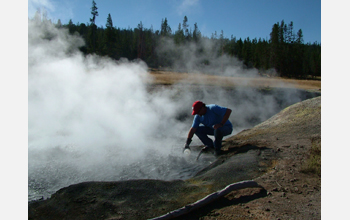Multimedia Gallery
Collecting water samples from Obsidian Hot Spring
David Mead of Lucigen Corporation collects a water sample from Obsidian Hot Spring in Yellowstone National Park. The sample will be grown in the lab to understand the adaptations that allow life at these temperatures and to uncover genes for heat-stable proteins encoded by these heat-loving organisms.
More about this image
Such proteins have been useful for a wide range of purposes from cancer research to disease diagnosis to biofuel production. An advantage of bioprospecting over traditional prospecting (i.e., mining for precious metals) is that bioprospecting requires only a single collection of extremely small amounts of biological material that is propagated in the lab. This allows bioprospectors to follow leave-no-trace practices in their research. The only samples removed from the spring are small samples of water. When possible, samples are collected in outflow channels, removing only water that would immediately flow into nearby rivers.
This research was initiated through NSF Small Business Innovation Research (SBIR) Phase I and II awards (DMI 0109756 and DMI 0215988) to Lucigen. Ongoing work on the project is currently supported by an additional grant (IIP 0839404), awarded to Lucigen. (Date of Image: 2005-2007)
Credit: David Mead, Lucigen Corporation
Images and other media in the National Science Foundation Multimedia Gallery are available for use in print and electronic material by NSF employees, members of the media, university staff, teachers and the general public. All media in the gallery are intended for personal, educational and nonprofit/non-commercial use only.
Images credited to the National Science Foundation, a federal agency, are in the public domain. The images were created by employees of the United States Government as part of their official duties or prepared by contractors as "works for hire" for NSF. You may freely use NSF-credited images and, at your discretion, credit NSF with a "Courtesy: National Science Foundation" notation.
Additional information about general usage can be found in Conditions.
Also Available:
Download the high-resolution JPG version of the image. (780 KB)
Use your mouse to right-click (Mac users may need to Ctrl-click) the link above and choose the option that will save the file or target to your computer.



 All images in this series
All images in this series